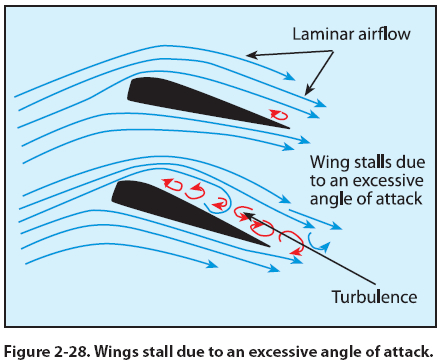Chapter 2 - Aerodynamics of Flight
Porpoising Creates Variations in AOA
Another slight variation in the angle of attack is the
swinging pendulum action of the PPC when high
thrust engines provide strong and immediate full
thrust of the propeller. This extra thrust swings the
cart through the pendulum arc relative to its position
under the wing. This is why many times you will see
the PPC take off and porpoise until it stabilizes. This
is a good example of the dynamic pendulum effect.
As the propeller thrust swings the cart out front, the
cart peaks then swings back to center. The cart successively
swings back and forth, continuing to reduce
oscillations until it stabilizes in a climb. This porpoising
is most common with a high power engine. This
can be eliminated by using gradual throttle increases
so as not to create a dynamic pendulum effect entering
a climb.
Stalls: Exceeding the Critical Angle of Attack
The critical angle of attack is the angle of attack at
which a wing stalls regardless of airspeed, flight attitude,
or weight. The drawings in Figure 2-28 show
airflow over a typical rectangular PPC wing. The first
shows a laminar, smooth, lift-generating airflow—one
that is typical when the angle of attack is within the
flight range. The second depicts an exceeded angle
of attack, turbulence and loss of the lifting force.
[Figure 2-28]

Unlike a fixed-wing aircraft that takes constant awareness
of angle of attack to prevent a stall, the powered
parachute wing is designed by the manufacturers to
maintain a specified range of angle of attack and airspeeds.
It is resistant to stalls because for all practical
purposes, it is designed to fly at a constant normal operating
range. This range is maintained if the operator
flies within the operating limitations specified in the
POH. Flying the PPC within the limitations specified
in the POH and avoiding turbulence means you will
not exceed the critical angle of attack and stall the
wing.
However, situations that could contribute to a stall are:
• A large increase in wing drag (full-flare)
— which the PPC pilot controls by pulling the
wing back, thus increasing the AOA. (Note: A
full-flare is normally used and recommended
only for landings.)
• A quick full RPM throttle input, creating a
climbing dynamic pendulum effect loading the
wing.
• A quick reduction of throttle during a high pitch
angle climb. This quickly turns a high pitch
climb into a high angle of attack. The wing is
initially pitched high, climbing the inclined
plane under full power, then quickly changes
to a gliding flight path when the throttle is
reduced, just like an airplane.
• A wind gust from flying in turbulent air.
To prevent a stall, do not go to full-throttle while holding
a full-flare, or as specified in the POH. Note: For
explanation of a stall recovery, see Chapter 12: Night,
Abnormal, and Emergency Procedures.
|

